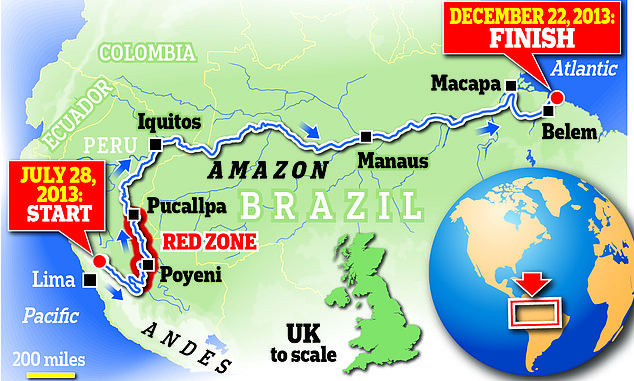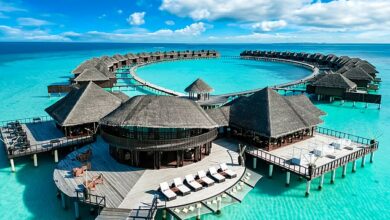Lethal rapids, foot rot… and a close encounter with machete-wielding ‘river pirates’. The incredible story of how a middle-aged British IT worker became the first man to kayak down the Amazon – just so he could impress his grandchildren

Sheer cliffs, hundreds of feet high, lined the banks of the river and there were terrifying rapids as far as the eye could see. From a kayaker’s point of view, it was a nightmare scenario.
In normal circumstances, David Midgley, along with the two expert paddlers he’d convinced to accompany him on his attempt to become the first person to kayak the Amazon from source to sea, would have carefully inspected the route ahead.
But the manager of the 2,000 men working on the construction of a hydroelectric plant on the riverbank had agreed only a brief suspension of his dynamiting of the site to give the kayakers safe passage.
That time pressure, coupled with the fact that the workers had made the banks impassable with quicksand and loose debris, meant that David and his companions had to limit their recce to a brief paddle in quieter waters upstream.
What they saw would test anyone’s resolve. Massive boulders – some the size of small houses – dotted the river, creating a maelstrom of white water.
The most intimidating challenge was a 15ft-high cascade stretching almost the entire width of the river. The fast-flowing water, given extra impetus by gravity as it crested the top of the waterfall, hit the river below with such force that it created a violent churn effect.

The grand scale of the Amazon River crosses the width of South America… it took half a year for David Midgley to complete the coast-to-coast journey in a kayak

David Midgley’s mission to became one of the first people to kayak the distance of the Amazon River was birthed on a paper tablecloth in a Scottish pub

Massive boulders, some the size of small houses, dotted the river for David to negotiate
This is a feature that seasoned kayakers – with masterly understatement – call a ‘hole’. This one might have been better termed a death-trap.
And as David, Don Beveridge and Darcy Gaechter climbed into their boats, their morale was not helped by the sight of the workers on the clifftops above them making throat-cutting gestures.
Don was the first to brave the roaring torrent that day in 2013. He paddled across the river to the far bank, where a narrow corridor of water made it possible to avoid the hole.
Once Don had disappeared from view, David followed him, doing his best to keep to the same line. But then disaster struck.
‘The current was so strong that, try as I might, I just couldn’t get across and found myself being dragged to the edge of the hole,’ David recalls.
‘There was a moment of sheer terror when I was swept over the top and, once I hit the water below, my kayak started being tossed around as if I was inside a gigantic washing machine.
‘My training kicked in. I could hear Don’s voice in my head saying: “Keep up your momentum” and “don’t get established in the hole”. If you do, there is no option but to get out of your kayak and make a swim for it. But that would have meant almost certain death as the rushing water would have smashed me against rocks as it carried me downriver.’
From his vantage point hugging the right bank, Don saw what had happened and, convinced that there was no way David could get out of the hole alive, said his goodbyes.
However, after what seemed like an age, the hole spat David out – upside down.
‘Roll up, roll up!’ screamed Darcy, and – while David could not have possibly heard her as his helmeted head was underwater – he did just that and managed to join Don and Darcy in the safety of their eddy.
I should declare an interest at this stage: David is my brother and I was with him when he first sketched out a rough outline of his Amazonian odyssey on a paper tablecloth in a Scottish pub.
Most brainwaves that seem like a good idea after a few pints washed down with whisky chasers never see the light of day: but this was one that did. Now, over a decade since he set off, David – an IT specialist by background – is discussing the expedition publicly for the first time.
As he puts it: ‘I just wanted to be able to tell my grandchildren that I did more with my life than sit at a computer writing code.’
He briefly considered an Everest expedition but rejected that idea on the basis that so many people had already done it. A round-the-world sailing voyage was ruled out for the same reason.
The idea of kayaking the river that carries 20 per cent of the world’s fresh water and stretches a distance equivalent to that between New York and Rome came after he realised that more people had walked on the moon than gone down the Amazon – and that no one had ever done it in a kayak.

David takes in the South American scenery from his kayak with adventurer Don Beveridge

The Amazon River contains 20 per cent of the world’s fresh water and had yet to been completed by kayak before David and co. took the plunge
For a man who had never so much as been camping, taking on a five-month, 4,200-mile odyssey – including a death-defying stretch of whitewater in the upper section – was ambitious to say the least.
David, then 41, set about preparing for his mission with characteristic single-mindedness. First he signed up for the beginners’ course at London’s Regents Canoe Club and, after kayaking in Norway, the US, Costa Rica, Morocco, France, Spain, Italy, Slovenia and Ecuador – where Don and Darcy turned him into a kayaker capable of coping with Class 5 rapids (the highest category) – he was ready for the ultimate challenge.
When the time came, he also had the wherewithal to fund the project. A piece of software he had written was proving to be a goldmine and so he was in a position to stump up the estimated £100,000 required to fund the enterprise, including the hire of a ‘gin-palace’ to cruise down river with them once the Amazon morphed from a mountainous torrent into a something more like a millpond.
Such was the project’s inherent level of risk that one of the team, Darcy, even went so far as to write an ‘in the event of my death’ letter to her parents and sister.
The first problem that confronted the intrepid trio was establishing the exact location of the source of the Amazon. Since the 1950s, conventional wisdom had decreed that the origin of the Apurimac river was the tributary source most distant from the Amazon’s estuary but – the year before the expedition was due to take place – an American kayaker and neuroscientist called Rocky Contos discovered that the Mantaro River was up to 50 miles longer than the Apurimac. His assessment was subsequently accepted by the Royal Geographical Society.
And so on July 28, 2013, after a marathon ride in a van carrying kayaks and equipment, David found himself 15,000ft up in the Peruvian Andes sitting in a kayak on Lago Acucocha, the ultimate source of a river that was to grow to encompass bays wider than the English Channel and an island the size of Switzerland. At that altitude, the nights were bitterly cold and the kayakers would wake each morning to find their socks frozen solid.

David Midgley (right) stands with fellow kayakers Don Beveridge (left) and Darcy Gaechter

David’s arduous challenge meant that every moment of rest was well earned
After an initial period when they were restocked by a team following them in a van, they entered the Mantaro’s deepest canyon and were forced to carry all their supplies and equipment in the tiny compartments in the back of their kayaks – everything from tents and food to a satellite phone and treatment kits for gunshot wounds (part of the route encompassed bandit country).
The first 200 miles of the trip promised to be the most perilous, as that trickle swiftly grew to become one of the most challenging stretches of whitewater in the world.
‘I’m not ashamed to admit that every morning for the first month I woke up scared,’ says David.
After the treacherous upper reaches, dangers of a different sort awaited him. On Day 25 of their mission, the team reached the point where the river flattened out as the Andes gave way to the Peruvian rainforest, an area known as the Red Zone, a place where Shining Path Maoist guerrillas had killed two tourists in kayaks a year earlier.
By 2013, it was also known as the world’s biggest cocaine-producing region and drug traffickers were the main threat. But this lawless stretch was also home to ‘assaltantes’, literally ‘robbers’ but better translated as ‘river pirates’. In addition, illegal loggers, ruthless poachers and tribes of indigenous peoples – with a well-founded wariness of outsiders – did not promise much of a welcome.
Before embarking on their journey, the group had obtained the necessary permissions to pass through their territory and hired a local guide called Cesar, who accompanied them in a motorised canoe.
But three days into the Red Zone, after failing to radio ahead as instructed for fear of alerting any undesirables in the area, they were summoned to the riverbank by locals.
‘There were about six of them and they were all armed to the teeth with a mixture of shotguns, machetes and knives,’ recalls David. ‘It was all a bit hair-raising, especially when they said that despite our profuse apologies we would have to “pay the consequences” of our trespassing.
‘Fortunately, they were messing with our heads and the only penalty involved Cesar being ordered to do 20 press-ups.’

Mother Nature throwed everything at the adventurers, with 15ft high cascades being the most frightening to tackle

There was no shortage of spectacular scenery as the trio travelled along the river
The kayakers were offered some peace of mind half way through their two-week passage through the Red Zone when they came across a Peruvian Navy patrol boat and its concerned captain insisted on escorting them out of the badlands.
After escaping the Red Zone at Pucallpa, the kayakers rendezvoused with the Perolita: the 42ft, two-storey motor-cruiser David had arranged to meet them. At last there was no need to dig a hole every time they needed to go to the lavatory.
After carefully logging their GPS co-ordinates so they could begin the next day’s paddle at precisely the spot where they had stopped the day before, they were also able to begin their evenings with an iced G&T on the foredeck.
And instead of boiling water over a stove to reconstitute freeze-dried rations, the Perolita’s on-board cook prepared local delicacies such as deep-fried yucca plant and catfish caught fresh from the Amazon.
There was also some sight-seeing to be done, with a visit to Iquitos (population 480,000) – the world’s biggest city inaccessible by road, whose inabitants are forced to come and go by air or river.
While the adrenaline-pumping danger of the white water was behind them, the flat section of the Amazon had dangers of its own.
During a recce rafting trip to Peru a few years earlier, David had been bitten by a sandfly and developed a suppurating sore that refused to go away.
It proved to be a skin infection called cutaneous leishmaniasis and he duly spent up to four hours a day for three weeks at the London School of Hygiene and Tropical Medicine hooked up to a drip leading from a bottle emblazoned with a skull-and-crossbones label.
And so when it came to the expedition proper, everyone was doped up to the eyeballs on anti-malarials. Unfortunately, this had the side-effect of making them acutely sensitive to sunlight and they had to paddle with socks on their hands.
Foot rot was another hazard as they spent all day with their feet in water sloshing around the bottom of their kayaks.
Meanwhile, the elements were a constant challenge. Apart from the suffocating heat – the daytime temperature could easily reach 40C – torrential rainfall was an almost daily occurrence during the wet season and on some days the wind was so strong that generating any forward motion proved impossible.
After 148 days of paddling, however, the trio reached the mouth of the Amazon delta and found an expanse of rock where they could set up camp in advance of making their final push to the sea the next day.

David poses with two of his tour guides, armed to navigate the most dangerous of stretches
But the Amazon had one last challenge for them. Rachel, David’s girlfriend, had warned him the previous day that other expeditions had been caught out by the tide.
‘We got woken in the middle of the night by the water lapping over our sleeping bags,’ says David. ‘The rock we were sleeping on was disappearing under the rising tide and we had to get out of our sleeping bags and into our kayaks as fast as we could.
‘We spent the next few hours holding onto the branches of mangroves in the pitch-black in a desperate attempt to avoid being swept away by the massive swell at the mouth of the world’s biggest river. After what felt like an eternity, the sun came up and the tide turned.’
By now they had only one task remaining: to locate the point where the river became the ocean. ‘With a huge tide now pushing us into the Atlantic Ocean, it didn’t take us long to get to the point where the land gave way to the sea.
‘Finally we landed on a beautiful white sand beach, located where the high tide mark was – very important after the previous night’s experience – and made camp after polishing off a bottle of bubbly we had stored in the back of a boat for this very occasion.
‘That night I was in tears. Nine years after tipsily announcing I was going to kayak the Amazon from source to sea and everyone thinking it was the drink talking, I’d done it.’
For more info, go to kayaktheamazon.com.




